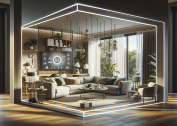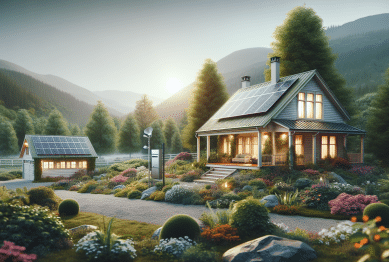Home interiors in 2025 are evolving into deeply personal spaces where emotion, wellness, and individuality merge. This trend—emotional wellness home interiors—is shaping how we live, from the lights above to the textures underfoot. Let’s explore how you can transform your space into a sanctuary that reflects your personality, nurtures your well-being, and stays on the cutting edge of design.

Why “Emotional Wellness Home Interiors” Matter
As one designer put it, “homes are becoming peaceful, health-promoting environments” with sensory elements such as circadian lighting, aroma diffusion, soundscaping, and natural materials becoming mainstream and affordable. The goal? Creating interiors that don’t just look beautiful, but feel deeply personal and emotionally supportive.
Unlike past eras that prioritized minimalist aesthetics, today’s design movement champions emotional texture and deeply personal connection. Think curated drapery that doubles as sculptural statements, or rich, soft materials like velvet and bouclé that invite touch and comfort. These trends align with the core principle of emotional wellness home interiors: designing spaces that feel alive and true to who you are.
Top Sensory-Driven Elements for Emotional Wellness Home Interiors
Here are key design strategies to embrace this emerging trend:
1. Sensory Lighting & Atmosphere
- Circadian lighting supports natural mood and energy cycles with warm-to-cool color shifts.
- Indirect, soft lighting, such as concealed LEDs or textured shades, reduces glare and fosters calm.
- Ambient lighting setups in spa-inspired areas—featuring water features, ergonomic furniture, and natural materials—help create tranquil environments that soothe the mind.
2. Texture & Tactility
- Plush fabrics like velvet, bouclé, or soft weaves invite touch and create cozy comfort.
- Using natural materials—stone, wood, clay—adds grounding presence and emotional warmth.
- Techniques like material drenching—cladding entire rooms in one textured material—enhance mood and anchor a space visually and emotionally.
3. Scent, Sound & Air Quality
- Aroma diffusion with subtle essential oils helps tailor ambiance—lavender for relaxation, citrus for clarity.
- Soundscaping, including soft ambient sound or nature-inspired audio, strengthens emotional comfort.
- Smart home systems that enhance air and water quality and offer energy recovery support physical well-being alongside emotional comfort.
4. Personalized, Story-Rich Touches
- Thoughtfully arranged curated displays—family keepsakes, art, heirlooms—make spaces expressive and unique.
- Designing multi-functional entertainment or wellness zones (like a cozy reading nook or small spa area) reflects your lifestyle and emotional needs.
- Incorporating visual drama through oversized drapery as installation, maximalist pattern layering, or carefully styled vignettes adds personality and soul.
How to Design Your Own Emotional Wellness Home Interiors
Ready to design a space that mirrors who you are—full of texture, comfort, personalization, and sensory richness? Here’s a practical guide to help you get started.
Step 1: Define Your Emotional Goals
Ask yourself:
- What feelings do I want in this space—calm, joy, creativity, togetherness?
- Consider a “sensory audit”: how might color, light, texture, scent, and sound support those feelings?
Once this is clear, move into design thinking aligned with emotional wellness home interiors.
Step 2: Layer Sensory Foundations
Lighting
- Use dimmers or smart bulbs to mimic natural light changes.
- Mix ambient floor or table lamps with overhead lighting to eliminate harshness.
- For real serenity, consider spa-style indirect lighting with water reflections and soft glow.
Texture
- Add cushioned seating in velvet or bouclé for tactile comfort.
- Integrate natural materials—wood tables, stone accent pieces—to ground your decor.
- If bold, try a feature wall in plaster, rich wood, or fabric for a material-drenched focal point
Scent & Sound
- Introduce electric diffusers with calming scents like sandalwood or eucalyptus.
- Use Bluetooth speakers or ambient sound systems to play soft waves, rain, or ambient music.
- Improve air quality with purification systems that blend into your interior.
Step 3: Infuse Personal Storytelling
Display meaningful objects like travel souvenirs or family photos in curated vignettes. A modern display cabinet can serve as both storage and a canvas for personal memory
Create dual-purpose zones: a meditation corner with plush cushions, soft lighting, and a plant; or a small games or reading room that feels playful yet high-end
Choose texture and pattern boldly: embrace maximalism—pattern-drench textiles or layered prints—for vibrant expression
Step 4: Ensure Emotional Coherence
Avoid clutter by thoughtfully grouping items—vary heights, balances, and color tones in displays
Balance sensory inputs: too much stimulus (sound, scent, texture) can overwhelm. Respect a “less is more” principle where each element earns its place and supports emotional intent.
Test before committing: use swatches, dimmers, and small prototypes—lighting, fabric, fragrance—to sample how each layer feels in real time.
Step 5: Adapt and Refine Over Time
Live with it: observe how your space makes you feel. Does the scent fade? Is the sound too constant? Adjust using dimmers, scent schedules, or rotating décor elements.
Seasonal shifts: colder months may benefit from warmer tones and softer textures; summers welcome lighter materials, increased greenery, and citrus scents.
Let your personality evolve: as your tastes or mood change, experiment—change throws, rotate meaningful objects, or adjust your sensory profile to match your mind-state.
Conclusion
The trend toward emotional wellness home interiors represents more than aesthetic—it’s about crafting spaces that reflect your personality, support your emotional needs, and offer sanctuary in a fast-paced world. By layering light, texture, scent, sound, and personal storytelling, your home becomes a sanctuary that’s authentically you.
This trend shows no signs of fading. Rather, it’s becoming the standard for modern living spaces—spaces that nourish rather than just decorate. Whether through smart systems, sensory textures, wellness zones, or personal objects, embracing emotional architecture is the next frontier of interior design.
Want help tailoring this to your home layout or style preferences? Just say the word!
References:
- Sensory and wellness-driven design becoming mainstream and affordable https://www.dailytelegraph.com.au/real-estate/national/rise-of-emotional-architecture-and-wellness-in-homes/news-story/b0ee5a6a3fcf99b865d48f302123845d?utm_source=chatgpt.com
- Spa-like home transforms using indirect lighting, water features, natural materials https://www.architecturaldigest.com/story/how-to-create-home-spa?utm_source=chatgpt.com
- Plush fabrics such as velvet and bouclé growing in popularity https://www.vogue.com/article/interior-design-trends-2025?utm_source=chatgpt.com









